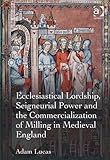Ecclesiastical lordship, seigneurial power and the commercialization of milling in medieval England / Adam Lucas.
Material type: TextCopyright date: ©2014Description: 1 online resource (437 pages)Content type:
TextCopyright date: ©2014Description: 1 online resource (437 pages)Content type: - 9781409421979
- 140942197X
- 9781409473176
- 1409473171
- 1409421961
- 9781409421962
- 1317146476
- 9781317146476
- 1317146468
- 9781317146469
- Monasticism and religious orders -- Economic aspects -- England -- History
- Monasteries -- Economic aspects -- England -- History
- Monastic and religious life -- England -- History
- Mills and mill-work -- England -- History
- Monachisme et ordres religieux -- Aspect économique -- Angleterre -- Histoire
- Vie religieuse et monastique -- Angleterre -- Histoire
- BUSINESS & ECONOMICS -- Industries -- General
- Mills and mill-work
- Monastic and religious life
- Monasticism and religious orders -- Economic aspects
- England
- 338.4/766472009420902 23
- BX2462 .L83 2014
- online - EBSCO
| Item type | Current library | Call number | URL | Status | Notes | Barcode | |
|---|---|---|---|---|---|---|---|
 eBook
eBook
|
Biblioteca "Angelicum" Pont. Univ. S.Tommaso d'Aquino Nuvola online | online - EBSCO (Browse shelf(Opens below)) | Online access | Not for loan (Accesso limitato) | Accesso per gli utenti autorizzati / Access for authorized users | (ebsco)797027 |
Browsing Biblioteca "Angelicum" Pont. Univ. S.Tommaso d'Aquino shelves, Shelving location: Nuvola online Close shelf browser (Hides shelf browser)
Includes bibliographical references and index.
Cover; Contents; Acknowledgements; Abbreviations; Note on Currency; Glossary of Medieval Terms; List of Figures; List of Charts; List of Tables; Introduction; 1 The Social and Economic Foundations of English Monasticism, c.600-1450; 2 Feudal Land Tenure, Ecclesiastical Patronage and Milling Monopolies; 3 The Commercialization of English Milling, 1086-1450; 4 Bishoprics and Archbishoprics; 5 The Benedictines; 6 The Augustinians; 7 The Cistercians; 8 The Minor Orders; 9 English Mill Law, Seigneurial Rights and Ecclesiastical Lordship.
10 Ecclesiastical Lordship and the Commercialization of Medieval MillingAppendix A; Appendix B; Appendix C; Appendix D; Appendix E; Bibliography; Index.
This is the first detailed study of the role of the Church in the commercialization of milling in medieval England. Focusing on the period from the late eleventh to the mid sixteenth centuries, it examines the estate management practices of more than thirty English religious houses founded by the Benedictines, Cistercians, Augustinians and other minor orders, with an emphasis on the role played by mills and milling in the establishment and development of a range of different sized episcopal and conventual foundations.
English.









